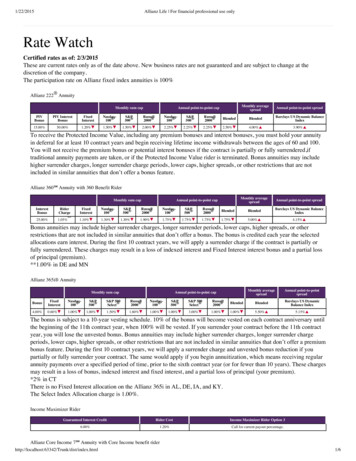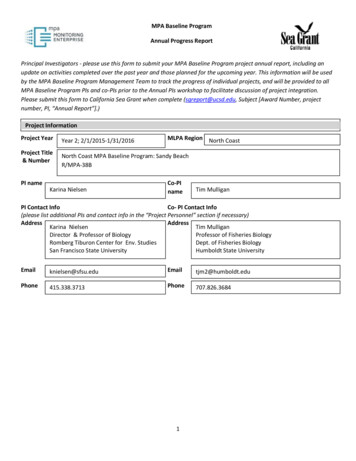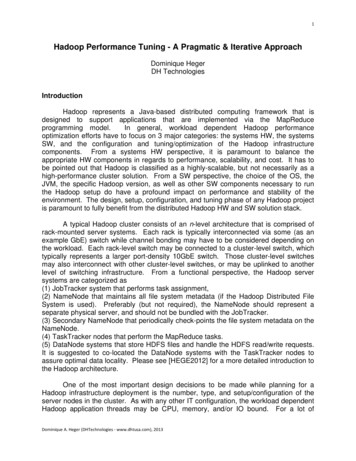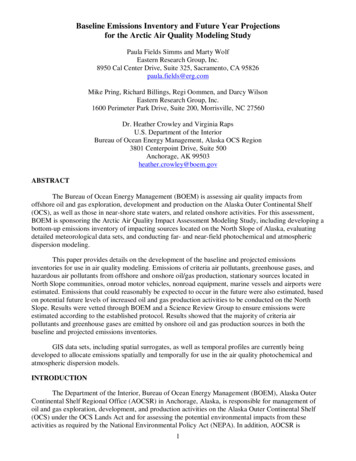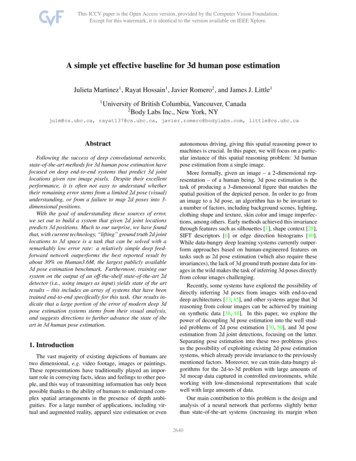
Transcription
A simple yet effective baseline for 3d human pose estimationJulieta Martinez1 , Rayat Hossain1 , Javier Romero2 , and James J. Little11University of British Columbia, Vancouver, Canada2Body Labs Inc., New York, NYjulm@cs.ubc.ca, rayat137@cs.ubc.ca, javier.romero@bodylabs.com, little@cs.ubc.caAbstractFollowing the success of deep convolutional networks,state-of-the-art methods for 3d human pose estimation havefocused on deep end-to-end systems that predict 3d jointlocations given raw image pixels. Despite their excellentperformance, it is often not easy to understand whethertheir remaining error stems from a limited 2d pose (visual)understanding, or from a failure to map 2d poses into 3dimensional positions.With the goal of understanding these sources of error,we set out to build a system that given 2d joint locationspredicts 3d positions. Much to our surprise, we have foundthat, with current technology, “lifting” ground truth 2d jointlocations to 3d space is a task that can be solved with aremarkably low error rate: a relatively simple deep feedforward network outperforms the best reported result byabout 30% on Human3.6M, the largest publicly available3d pose estimation benchmark. Furthermore, training oursystem on the output of an off-the-shelf state-of-the-art 2ddetector (i.e., using images as input) yields state of the artresults – this includes an array of systems that have beentrained end-to-end specifically for this task. Our results indicate that a large portion of the error of modern deep 3dpose estimation systems stems from their visual analysis,and suggests directions to further advance the state of theart in 3d human pose estimation.1. IntroductionThe vast majority of existing depictions of humans aretwo dimensional, e.g. video footage, images or paintings.These representations have traditionally played an important role in conveying facts, ideas and feelings to other people, and this way of transmitting information has only beenpossible thanks to the ability of humans to understand complex spatial arrangements in the presence of depth ambiguities. For a large number of applications, including virtual and augmented reality, apparel size estimation or evenautonomous driving, giving this spatial reasoning power tomachines is crucial. In this paper, we will focus on a particular instance of this spatial reasoning problem: 3d humanpose estimation from a single image.More formally, given an image – a 2-dimensional representation – of a human being, 3d pose estimation is thetask of producing a 3-dimensional figure that matches thespatial position of the depicted person. In order to go froman image to a 3d pose, an algorithm has to be invariant toa number of factors, including background scenes, lighting,clothing shape and texture, skin color and image imperfections, among others. Early methods achieved this invariancethrough features such as silhouettes [1], shape context [28],SIFT descriptors [6] or edge direction histograms [40].While data-hungry deep learning systems currently outperform approaches based on human-engineered features ontasks such as 2d pose estimation (which also require theseinvariances), the lack of 3d ground truth posture data for images in the wild makes the task of inferring 3d poses directlyfrom colour images challenging.Recently, some systems have explored the possibility ofdirectly inferring 3d poses from images with end-to-enddeep architectures [33, 45], and other systems argue that 3dreasoning from colour images can be achieved by trainingon synthetic data [38, 48]. In this paper, we explore thepower of decoupling 3d pose estimation into the well studied problems of 2d pose estimation [30, 50], and 3d poseestimation from 2d joint detections, focusing on the latter.Separating pose estimation into these two problems givesus the possibility of exploiting existing 2d pose estimationsystems, which already provide invariance to the previouslymentioned factors. Moreover, we can train data-hungry algorithms for the 2d-to-3d problem with large amounts of3d mocap data captured in controlled environments, whileworking with low-dimensional representations that scalewell with large amounts of data.Our main contribution to this problem is the design andanalysis of a neural network that performs slightly betterthan state-of-the-art systems (increasing its margin when12640
the detections are fine-tuned, or ground truth) and is fast (aforward pass takes around 3ms on a batch of size 64, allowing us to process as many as 300 fps in batch mode), whilebeing easy to understand and reproduce. The main reasonfor this leap in accuracy and performance is a set of simpleideas, such as estimating 3d joints in the camera coordinateframe, adding residual connections and using batch normalization. These ideas could be rapidly tested along with otherunsuccessful ones (e.g. estimating joint angles) due to thesimplicity of the network.The experiments show that inferring 3d joints fromgroundtruth 2d projections can be solved with a surprisinglylow error rate – 30% lower than state of the art – on thelargest existing 3d pose dataset. Furthermore, training oursystem on noisy outputs from a recent 2d keypoint detector yields results that slightly outperform the state-of-the-arton 3d human pose estimation, which comes from systemstrained end-to-end from raw pixels.Our work considerably improves upon the previous best2d-to-3d pose estimation result using noise-free 2d detections in Human3.6M, while also using a simpler architecture. This shows that lifting 2d poses is, although farfrom solved, an easier task than previously thought. Sinceour work also achieves state-of-the-art results starting fromthe output of an off-the-shelf 2d detector, it also suggeststhat current systems could be further improved by focusing on the visual parsing of human bodies in 2d images.Moreover, we provide and release a high-performance, yetlightweight and easy-to-reproduce baseline that sets a newbar for future work in this task. Our code is publicly available at .2. Previous workDepth from images The perception of depth from purely2d stimuli is a classic problem that has captivated the attention of scientists and artists at least since the Renaissance,when Brunelleschi used the mathematical concept of perspective to convey a sense of space in his paintings of Florentine buildings.Centuries later, similar perspective cues have been exploited in computer vision to infer lengths, areas and distance ratios in arbitrary scenes [57]. Apart from perspectiveinformation, classic computer vision systems have tried touse other cues like shading [53] or texture [25] to recoverdepth from a single image. Modern systems [12, 26, 34, 39]typically approach this problem from a supervised learningperspective, letting the system infer which image featuresare most discriminative for depth estimation.Top-down 3d reasoning One of the first algorithms fordepth estimation took a different approach: exploiting theknown 3d structure of the objects in the scene [37]. It hasbeen shown that this top-down information is also used byhumans when perceiving human motion abstracted into aset of sparse point projections [8]. The idea of reasoningabout 3d human posture from a minimal representation suchas sparse 2d projections, abstracting away other potentiallyricher image cues, has inspired the problem of 3d pose estimation from 2d joints that we are addressing in this work.2d to 3d joints The problem of inferring 3d joints fromtheir 2d projections can be traced back to the classic workof Lee and Chen [23]. They showed that, given the bonelengths, the problem boils down to a binary decision treewhere each split correspond to two possible states of ajoint with respect to its parent. This binary tree can bepruned based on joint constraints, though it rarely resultedin a single solution. Jiang [20] used a large databaseof poses to resolve ambiguities based on nearest neighbor queries. Interestingly, the idea of exploiting nearestneighbors for refining the result of pose inference has beenrecently revisited by Gupta et al. [14], who incorporatedtemporal constraints during search, and by Chen and Ramanan [9]. Another way of compiling knowledge about 3dhuman pose from datasets is by creating overcomplete basessuitable for representing human poses as sparse combinations [2, 7, 36, 49, 55, 56], lifting the pose to a reproduciblekernel Hilbert space (RHKS) [18] or by creating novel priors from specialized datasets of extreme human poses [2].Deep-net-based 2d to 3d joints Our system is most related to recent work that learns the mapping between 2dand 3d with deep neural networks. Pavlakos et al. [33]introduced a deep convolutional neural network based onthe stacked hourglass architecture [30] that, instead of regressing 2d joint probability heatmaps, maps to probability distributions in 3d space. Moreno-Noguer [27] learnsto predict a pairwise distance matrix (DM) from 2-to-3dimensional space. Distance matrices are invariant upto rotation, translation and reflection; therefore, multidimensional scaling is complemented with a prior of humanposes [2] to rule out unlikely predictions.A major motivation behind Moreno-Noguer’s DM regression approach, as well as the volumetric approach ofPavlakos et al., is the idea that predicting 3d keypointsfrom 2d detections is inherently difficult. For example,Pavlakos et al. [33] present a baseline where a direct 3djoint representation (such as ours) is used instead (Table 1in [33]), with much less accurate results than using volumetric regression1 Our work contradicts the idea that regressing 3d keypoints from 2d joint detections directly should1 This approach, however, is slightly different from ours, as the input isstill image pixels, and the intermediate 2d body representation is a seriesof joint heatmaps – not joint 2d locations.2641
x2Batch normLinear1024Batch normLinear1024RELUDropout 0.5RELU Dropout 0.5Figure 1. A diagram of our approach. The building block of our network is a linear layer, followed by batch normalization, dropout and aRELU activation. This is repeated twice, and the two blocks are wrapped in a residual connection. The outer block is repeated twice. Theinput to our system is an array of 2d joint positions, and the output is a series of joint positions in 3d.be avoided, and shows that a well-designed and simple network can perform quite competitively in the task of 2d-to-3dkeypoint regression.that performs well on this task. These goals are the mainrationale behind the design choices of our network.3.1. Our approach – network design2d to 3d angular pose There is a second branch of algorithms for inferring 3d pose from images which estimatethe body configuration in terms of angles (and sometimesbody shape) instead of directly estimating the 3d positionof the joints [4, 7, 31, 54]. The main advantages of thesemethods are that the dimensionality of the problem is lowerdue to the constrained mobility of human joints, and thatthe resulting estimations are forced to have a human-likestructure. Moreover, constraining human properties suchas bone lengths or joint angle ranges is rather simple withthis representation [51]. We have also experimented withsuch approaches; however in our experience the highly nonlinear mapping between joints and 2d points makes learningand inference harder and more computationally expensive.Consequently, we opted for estimating 3d joints directly.3. Solution methodologyOur goal is to estimate body joint locations in 3dimensional space given a 2-dimensional input. Formally,our input is a series of 2d points x R2n , and our outputis a series of points in 3d space y R3n . We aim to learna function f : R2n R3n that minimizes the predictionerror over a dataset of N poses:f minfN1 XL (f (xi ) yi ) .N i 1(1)In practice, xi may be obtained as ground truth 2d jointlocations under known camera parameters, or using a 2djoint detector. It is also common to predict the 3d positionsrelative to a fixed global space with respect to its root joint,resulting in a slightly lower-dimensional output.We focus on systems where f is a deep neural network,and strive to find a simple, scalable and efficient architectureFigure 1 shows a diagram with the basic building blocksof our architecture. Our approach is based on a simple, deep, multilayer neural network with batch normalization [17], dropout [44] and Rectified Linear Units (RELUs) [29], as well as residual connections [16]. Not depicted are two extra linear layers: one applied directly to theinput, which increases its dimensionality to 1024, and oneapplied before the final prediction, that produces outputsof size 3n. In most of our experiments we use 2 residualblocks, which means that we have 6 linear layers in total,and our model contains between 4 and 5 million trainableparameters.Our architecture benefits from multiple relatively recentimprovements on the optimization of deep neural networks,which have mostly appeared in the context of very deepconvolutional neural networks and have been the key ingredient of state-of-the-art systems submitted to the ILSVRC(Imagenet [10]) benchmark. As we demonstrate, these contributions can also be used to improve generalization on our2d-to-3d pose estimation task.2d/3d positions Our first design choice is to use 2d and3d points as inputs and outputs, in contrast to recent workthat has used raw images [11, 13, 24, 32, 33, 45, 46, 54, 56] or2d probability distributions [33, 56] as inputs, and 3d probabilities [33], 3d motion parameters [54] or basis pose coefficients and camera parameter estimation [2, 7, 36, 55, 56]as outputs. While 2d detections carry less information,their low dimensionality makes them very appealing towork with; for example, one can easily store the entire Human3.6M dataset in the GPU while training the network,which reduces overall training time, and considerably allowed us to accelerate the search for network design andtraining hyperparameters.2642
Linear-RELU layers Most deep learning approaches to3d human pose estimation are based on convolutional neural networks, which learn translation-invariant filters thatcan be applied to entire images [13, 24, 32, 33, 45], or 2dimensional joint-location heatmaps [33, 56]. However,since we are dealing with low-dimensional points as inputsand outputs, we can use simpler and less computationallyexpensive linear layers. RELUs [29] are a standard choiceto add non-linearities in deep neural networks.Residual connections We found that residual connections, recently proposed as a technique to facilitate the training of very deep convolutional neural networks [16], improve generalization performance and reduce training time.In our case, they helped us reduce error by about 10%.Batch normalization and dropout While a simple network with the three components described above achievesgood performance on 2d-to-3d pose estimation whentrained on ground truth 2d positions, we have discoveredthat it does not perform well when trained on the outputof a 2d detector, or when trained on 2d ground truth andtested on noisy 2d observations. Batch normalization [17]and dropout [44] improve the performance of our system inthese two cases, while resulting in a slight increase of trainand test-time.Max-norm constraint We also applied a constraint onthe weights of each layer so that their maximum norm isless than or equal to 1. Coupled with batch normalization,we found that this stabilizes training and improves generalization when the distribution differs between training andtest examples.3.2. Data preprocessingWe apply standard normalization to the 2d inputs and 3doutputs by subtracting the mean and dividing by the standard deviation. Since we do not predict the global positionof the 3d prediction, we zero-centre the 3d poses aroundthe hip joint (in line with previous work and the standardprotocol of Human3.6M).Camera coordinates In our opinion, it is unrealistic toexpect an algorithm to infer the 3d joint positions in an arbitrary coordinate space, given that any translation or rotation of such space would result in no change in the inputdata. A natural choice of global coordinate frame is thecamera frame [11, 24, 33, 46, 54, 56] since this makes the2d to 3d problem similar across different cameras, implicitly enabling more training data per camera and preventingoverfitting to a particular global coordinate frame. We doGT/GTGT/GT N (0, 5)GT/GT N (0, 10)GT/GT N (0, 15)GT/GT N (0, 20)GT/CPM [50]GT/SH [30]DMR [27]Ours ble 1. Performance of our system on Human3.6M under protocol #2. (Top) Training and testing on ground truth 2d joint locations plus different levels of additive gaussian noise. (Bottom)Training on ground truth and testing on the output of a 2d detector.this by rotating and translating the 3d ground-truth according to the inverse transform of the camera. A direct effectof inferring 3d pose in an arbitrary global coordinate frameis the failure to regress the global orientation of the person, which results in large errors in all joints. Note that thedefinition of this coordinate frame is arbitrary and does notmean that we are exploiting pose ground truth in our tests.2d detections We obtain 2d detections using the stateof-the-art stacked hourglass network of Newell et al. [30],pre-trained on the MPII dataset [3]. Similar to previouswork [19, 24, 27, 32, 46], we use the bounding boxes provided with H3.6M to estimate the centre of the person in theimage. We crop a square of size 440 440 pixels aroundthis computed centre to the detector (which is then resizedto 256 256 by stacked hourglass). The average error between these detections and the ground truth 2d landmarksis 15 pixels, which is slightly higher than the 10 pixels reported by Moreno-Noguer [27] using CPM [50] on the samedataset. We prefer stacked hourglass over CPM because (a)it has shown slightly better results on the MPII dataset, and(b) it is about 10 times faster to evaluate, which allowed usto compute detections over the entire H3.6M dataset.We have also fine-tuned the stacked hourglass model onthe Human3.6M dataset (originally pre-trained on MPII),which obtains more accurate 2d joint detections on our target dataset and further reduces the 3d pose estimation error.We used all the default parameters of stacked hourglass, except for minibatch size which we reduced from 6 to 3 dueto memory limitations on our GPU. We set the learning rateto 2.5 10 4 , and train for 40 000 iterations.Training details We train our network for 200 epochs using Adam [21], a starting learning rate of 0.001 and exponential decay, using mini-batches of size 64. Initially, theweights of our linear layers are set using Kaiming initialization [15]. We implemented our code using Tensorflow,which takes around 5ms for a forward backward pass, and2643
Protocol #1LinKDE [19] (SA)Li et al. [24] (MA)Tekin et al. [46] (SA)Zhou et al. [56] (MA)Tekin et al. [45] (SA)Ghezelghieh et al. [13] (SA)Du et al. [11] (SA)Park et al. [32] (SA)Zhou et al. [54] (MA)Pavlakos et al. [33] (MA)Direct. Discuss Eating Greet Phone Photo Pose Purch. Sitting SitingD Smoke Wait WalkD Walk 6 132.3 164.4 162.1 205.9 150.6 171.3 151.6136.9 96.9 124.7– 168.7–––147.2 88.8 125.3 118.0 182.7 112.4 129.2 138.9109.3 87.1 103.2 116.2 143.3 106.9 99.8 124.5129.1 91.4 121.7– 162.2–––80.4 78.1 89.7–––––112.7 104.9 122.1 139.1 135.9 105.9 166.2 117.5116.2 90.0 116.5 115.3 149.5 117.6 106.9 137.2102.4 96.7 98.8 113.4 125.2 90.0 93.8 132.271.9 66.7 69.1 72.0 77.0 65.0 68.3 .2130.5–137.4131.9126.074.9Avg96.6 127.9 162.170.0––55.1 65.8 125.079.4 97.7 113.065.8––95.1 82.2–99.3 106.5 126.562.6 96.2 117.379.0 99.0 107.359.1 63.2 71.9Ours (SH detections) (SA)Ours (SH detections) (MA)Ours (SH detections FT) 7.2 51.267.1 50.965.1 49.552.354.852.473.667.562.9Ours (GT detections) .447.6 36.440.445.5Table 2. Detailed results on Human3.6M [19] under Protocol #1 (no rigid alignment in post-processing). SH indicates that we trained andtested our model with Stacked Hourglass [30] detections as input, and FT indicates that the 2d detector model was fine-tuned on H3.6M.GT detections denotes that the groundtruth 2d locations were used. SA indicates that a model was trained for each action, and MA indicatesthat a single model was trained for all actions.around 2ms for a forward pass on a Titan Xp GPU. Thismeans that, coupled with a state-of-the-art realtime 2d detector (e.g., [50]), our network could be part of full pixelsto-3d system that runs in real time.One epoch of training on the entire Human3.6M datasetcan be done in around 2 minutes, which allowed us to extensively experiment with multiple variations of our architecture and training hyperparameters.4. Experimental evaluationDatasets and protocols We focus our numerical evaluation on two standard datasets for 3d human pose estimation:HumanEva [42] and Human3.6M [19]. We also show qualitative results on the MPII dataset [3], for which the groundtruth 3d is not available.Human3.6M is, to the best of our knowledge, currentlythe largest publicly available datasets for human 3d poseestimation. The dataset consists of 3.6 million images featuring 7 professional actors performing 15 everyday activities such as walking, eating, sitting, making a phone calland engaging in a discussion. 2d joint locations and 3dground truth positions are available, as well as projection(camera) parameters and body proportions for all the actors. HumanEva, on the other hand, is a smaller dataset thathas been largely used to benchmark previous work over thelast decade. MPII is a standard dataset for 2d human poseestimation based on thousands of short youtube videos.On Human3.6M we follow the standard protocol, usingsubjects 1, 5, 6, 7, and 8 for training, and subjects 9 and11 for evaluation. We report the average error in millimetres between the ground truth and our prediction across alljoints and cameras, after alignment of the root (central hip)joint. Typically, training and testing is carried out indepen-dently in each action. We refer to this as protocol #1. However, in some of our baselines, the prediction has been further aligned with the ground truth via a rigid transformation(e.g. [7,27]). We call this post-processing protocol #2. Similarly, some recent methods have trained one model for allthe actions, as opposed to building action-specific models.We have found that this practice consistently improves results, so we report results for our method under these twovariations. In HumanEva, training and testing is done onall subjects and in each action separately, and the error isalways computed after a rigid transformation.4.1. Quantitative resultsAn upper bound on 2d-to-3d regression Our method,based on direct regression from 2d joint locations, naturallydepends on the quality of the output of a 2d pose detector,and achieves its best performance when it uses ground-truth2d joint locations.We followed Moreno-Noguer [27] and tested under different levels of Gaussian noise a system originally trainedwith 2d ground truth. The results can be found in Table 1. Our method largely outperforms the Distance-Matrixmethod [27] for all levels of noise, and achieves a peakperformance of 37.10 mm of error when it is trained onground truth 2d projections. This is about 43% better thanthe best result we are aware of reported on ground truth 2djoints [27]. Moreover, note that this result is also about 30%better than the 51.9 mm reported by Pavlakos et al. [33],which is the best result on Human3.6M that we aware of –however, their result does not use ground truth 2d locations,which makes this comparison unfair.Although every frame is evaluated independently, andwe make no use of time, we note that the predictions produced by our network are quite smooth. A video with2644
Protocol #2Direct. Discuss Eating Greet Phone Photo Pose Purch. Sitting SitingD Smoke Wait WalkD Walk WalkTAkhter & Black [2]* (MA) 14j199.2Ramakrishna et al. [36]* (MA) 14j 137.4Zhou et al. [55]* (MA) 14j99.762.0Bogo et al. [7] (MA) 14j66.1Moreno-Noguer [27] (MA) 14jPavlakos et al. [33] (MA) 17j–177.6 161.8 197.8 176.2 186.5 195.4 167.3 160.7149.3 141.6 154.3 157.7 158.9 141.8 158.1 168.695.8 87.9 116.8 108.3 107.3 93.5 95.3 109.160.2 67.8 76.5 92.1 77.0 73.0 75.3 100.361.7 84.5 73.7 65.2 67.2 60.9 67.3 103.5––––––––Avg173.7 177.8 181.9 176.2 198.6 192.7 181.1175.6 160.4 161.7 150.0 174.8 150.2 157.3137.5 106.0 102.2 106.5 110.4 115.2 106.7137.3 83.4 77.3 86.8 79.7 87.7 82.374.6 92.6 69.6 71.5 78.0 73.2 74.0–––––– 51.9Ours (SH detections) (SA) 17jOurs (SH detections) (MA) 17jOurs (SH detections FT) (MA) 17j50.142.239.559.548.043.251.3 56.949.8 50.846.4 47.068.561.751.067.5 51.060.7 44.256.0 41.447.243.640.668.564.356.585.676.569.461.2 67.055.8 49.149.2 45.055.1 41.153.6 40.849.5 38.045.5 58.546.4 52.543.1 47.7Ours (SH detections) (SA) 14j44.852.044.4 50.561.759.4 45.141.966.377.654.0 58.849.0 35.940.7 52.1Table 3. Detailed results on Human3.6M [19] under protocol #2 (rigid alignment in post-processing). The 14j (17j) annotation indicatesthat the body model considers 14 (17) body joints. The results of all approaches are obtained from the original papers, except for (*), whichwere obtained from [7].S1Radwan et al. [35]Wang et al. [49]Simo-Serra et al. [43]Bo et al. [5]Kostrikov et al. [22]Yasin et al. [52]Moreno-Noguer [27]Pavlakos et al. [33]Ours (SH detections)WalkingS3 .929.046.8S1JoggingS2 able 4. Results on the HumanEva [42] dataset, and comparisonwith previous work.these and more qualitative results can be found at https://youtu.be/Hmi3Pd9x1BE.Robustness to detector noise To further analyze the robustness of our approach, we also experimented with testingthe system (always trained with ground truth 2d locations)with (noisy) 2d detections from images. These results arealso reported at the bottom of Table 1.2 In this case, we alsooutperform previous work, and demonstrate that our network can perform reasonably well when trained on groundtruth and tested on the output of a 2d detector.Training on 2d detections While using 2d ground truthat train and test time is interesting to characterize the performance of our network, in a practical application our system has to work with the output of a 2d detector. Wereport our results on protocol #1 of Human3.6M in Table 2. Here, our closest competitor is the recent volumetric prediction method of Pavlakos et al. [33], which usesa stacked-hourglass architecture, is trained end-to-end onHuman3.6M, and uses a single model for all actions. Our2 Thiswas, in fact, the protocol used in the main result of [27].method outperforms this state-of-the-art result by 4.4 mmeven when using out-of-the-box stacked-hourglass detections, and more than doubles the gap to 9.0 mm when the2d detector is fine-tuned on H3.6M. Our method also consistently outperforms previous work in all but one of the 15actions of H3.6M.Our results on Human3.6M under protocol #2 (using arigid alignment with the ground truth), are shown in Table 3.Although our method is slightly worse than previous workwith out-of-the-box detections, it comes first when we usefine-tuned detections.Finally, we report results on the HumanEva dataset inTable 4. In this case, we obtain the best result to date in 3out of 6 cases, and overall the best average error for actionsJogging and Walking. Since this dataset is rather small, andthe same subjects show up on the train and test set, we donot consider these results to be as significant as those obtained by our method in Human3.6M.Ablative and hyperparameter analysis We also performed an ablative analysis to better understand the impactof the design choices of our network. Taking as a basis ournon-fine tuned MA model, we present those results in Table 5. Removing dropout or batch normalization leads to3-to8 mm of increase in error, and residual connections account for a gain of about 8 mm in our result. However, notpre-processing the data to the network in camera coordinates results in error above 100 mm – substantially worsethan state-of-the-art performance.Last but not least, we analyzed the sensitivity of our network to depth and width. Using a single residual block results in a loss of 6 mm, and performance is saturated after 2blocks. Empirically, we observed that decreasing the layersto 512 dimensions gave worse performance, while layerswith 2 048 units were much slower and did not seem to increase the accuracy.2645
Figure 2. Example output on the test set of Human3.6M. Left: 2d observation. Middle: 3d ground truth. Right (green): our 3d predictions.Oursw/o batch normw/o dropoutw/o batch norm w/o dropoutw/o residual connectionsw/o camera coordinates1 block2 blocks (Ours)4 blocks8 blockserror (mm) 7.569.369.76.7–1.82.4Table 5. Ablative and hyperparameter sensitivity analysis.4.2. Qualitative resultsFinally, we show some qualitative results on Human3.6M in Figure 2, and from images “in the wild” fromthe test set of MPII in Figure 3. Our results on MPII revealsome of the limitations of our approach; for example, oursystem cannot recover from a failed detector
on 3d human pose estimation, which comes from systems trained end-to-end from raw pixels. Our work considerably improves upon the previous best 2d-to-3d pose estimation result using noise-free 2d detec-tions in Human3.6M, while also using a simpler archi-tecture. This show

